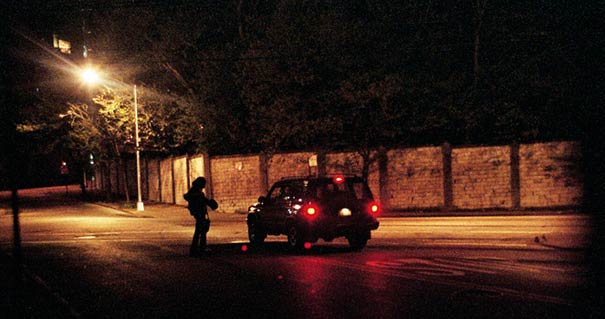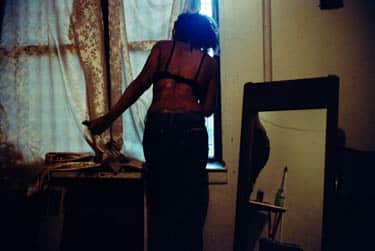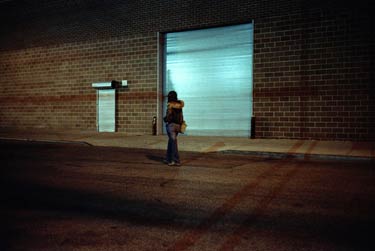by Angela Bonavoglia
In the wake of New York Governor Eliot Spitzer’s stunning fall from grace in March 2008 for spending some $80,000 on call girls, prostitution has come way out of the closet.
NBC News brought us self-proclaimed “ho-fessional” Brooke Taylor of Nevada’s Moonlite Bunny Ranch, in a web extra, promoting her work and her wares. Out came the film The Babysitters featuring a high school honor student who starts a babysitters’ prostitution ring. Now comes Showtime’s happy-go-lucky hooker in a new series, “Secret Diary of a Call Girl.”
Thousands of so-called “net walkers” run their own escort websites. David Elms created TheEroticReview.com to rate the women, telling the New York Times he did that because he thought the johns needed to be empowered. Craigslist.com is an essential resource for escort classifieds, though it’s unknown how long that will last with stings underway nationwide.
On the darker side, Spitzer’s call girl from the high-end elite escort service, Emperor’s Club V.I.P., which advertised educated, sophisticated, international fashion-model types, turned out to have been a broke, homeless, drug-using, abused teen just a few years before. That puts her in the company of the majority of women who enter the business as adolescents—average age 13, and those who enter for survival reasons, bringing horrendous histories of sexual and physical abuse, destitution, homelessness, addiction and despair.

The criminal life of the D.C. madam Deborah Jeane Palfrey, with her bevy of high-priced call girls serving politicos, caught up with her. Convicted and unable to face the prospect of life after jail, “penniless and alone,” she hung herself in her garage. That was after one of her former escorts, Brandy Britton, a previous university professor facing trial on prostitution charges, hung herself.
Through all this, the question looms: Can prostitution be a freely made choice? The issue has divided feminists for three decades. Resolving it is not an academic exercise. The rift between so-called “radical” or “cultural” feminists who see prostitutes as victims and “liberal” feminists who see prostitutes as sex workers with rights to self-determination is obscuring what agreement there is and delaying desperately needed reforms.
One Side of the Street
“Audrey” is, in some respects, a real-life version of the character Belle in the new Showtime Call Girl series. A white woman in her 30s, she grew up in rural Texas. “Sex work always fascinated me,” she says. “It represented a lot of freedom for a woman. Growing up in Baptist country, women didn’t have a lot of freedom or autonomy.”
Audrey began her career as a stripper, which got her through her senior year of college. Affirming that all sex work is not for every sex worker, she confesses that she burned out on stripping after a few years, done in by the relentless verbal abuse from the customers. In 2000, encouraged by another woman in the business, she moved on to sex work as a prostitute, which she’d always wanted to try. She chose a venue she could control, setting up her own escort service on the web, with a detailed vetting process and the ability to pick and choose her clients.
“It was very good for me, very effortless,” she says of her entry into the business. It is also somewhat sexually fulfilling. “I enjoy sex so I certainly enjoy this,” she says. “I don’t expect every client to be a sexual god or a sexual match with me because that’s not why they’re there. But I’ve had more good times than not. When you get along with somebody, it’s very easy to enjoy sex with them. It’s part of the human experience really.”
Asked how she feels about selling sex for money, Audrey doesn’t think that’s what she’s doing. “I’m not selling sex so much as I’m selling emotion, sexual entertainment, time and a human connection,” she says.
Audrey says that sex work has built her confidence. But it’s not a feeling she can enjoy in a culture that, on one hand, embraces the hooker with the heart of gold, while on the other, denounces whores as the lowest form of life. “You go out in society and you get smacked down for what you do, even though it’s been rather positive in your life and has done good things for you, because everyone sees it as horrible. That sense of pride and self-worth gets taken away.”
Audrey reports that she was not a victim of childhood sexual abuse. And while she was verbally harassed as a stripper, she reports that as a prostitute, she has “never had anything personally bad happen to me.”
The Less Sunny Side
That has not been Brenda Myers’ experience. An African-American woman whose mother died when she was very young, Myers grew up in extreme poverty, raised by a beloved, though alcoholic grandmother, in a disorganized, inner-city Chicago household. She was sexually molested as a young girl by multiple men.

A mother already and broke, Myers turned her first trick on the street at the age of 15. She was literally thrown into the trunk of a car by two pimps and held in a closet under “pimp arrest,” but she later managed to escape. Her next pimps were organized crime figures who moved her from state to state to work in indoor white establishments, which she only got into, she says, because she was a “very young, exceptionally attractive, light-skinned African-American girl.”
Myers admits that she got caught up early on in the glamour of “dating” TV, movie, song and sports celebrities. She says it was “very fascinating for a young girl,” especially one who was “desperate for someone, somewhere to see me.” But eventually Myers became a crack addict, aged out of that glitzy world, and tumbled back onto the pavement once again.
Throughout her years as a prostitute, Myers experienced the utter failure of the American criminal justice system to help her. Prostitution is illegal under state laws all over the country, with the exception of some counties in Nevada. While all parties are criminals—the women, the johns and the pimps—the wrath of the law falls hardest on women.
Men Get Off, Women Get Cuffed
At 15, Myers was arrested and dumped into the adult “whore tank” at the local jail. That was years ago, but today, many teenage girls who are victims of commercial sexual exploitation wind up in the same situation. In New York City, adolescents involved in a program called GEMS, devoted to helping them leave the life, have served time as teens at the city’s notorious prison on Rikers’ Island.
That means that, even as police authorities raided the polygamous compound in Texas to save one 16-year-old girl from sexual abuse, adult men all over this country were buying and selling girls for sexual services by the thousands with impunity. If money were not changing hands, those men could be charged as rapists, sodomists and pedophiles.
Violence—including murder (one study found prostitutes have a mortality rate 50 times higher than the national average)—is epidemic against prostitutes at the hands of pimps, johns and cops. But perpetrators are seldom brought to justice. When Myers was shot, the police came to the hospital and locked her up as soon as she got well, while they never found, nor to her knowledge even looked for, the trick who shot her. Myers was pushed out of a moving car by a john she’d just serviced, as they were being pursued by a police car. Instead of chasing the john when Myers crashed to the ground, the cops let him go, arresting her and putting her in jail.
Women of color prostitutes are the most common targets of the ailing legal system. Street prostitutes, those most likely to be arrested, are estimated to make up some ten to 15 percent of all prostitutes. Nationally, women of color account for 40 percent of street prostitutes, 55 percent of those arrested, and an astonishing 85 percent of those sentenced to jail.
Myers, who today helps other women escape prostitution, has no patience for the notion of prostitution as a legitimate occupation. “I don’t think it should be legal to buy any human being,” she says.
Prostitution as Violence Against Women
Myers’ sentiments are shared by ardent, long-time feminist leaders who seek to abolish prostitution. They speak of prostituted women, not prostitutes, and see prostitution as violence against women, a human rights violation, and always harmful, not only to the women directly involved. They see the harm as extending to all women because, according to the Coalition Against Trafficking in Women, “prostitution justifies the sale of any woman, reduces all women to sex, and eroticizes women’s inequality.”
With their focus on ending sexual trafficking in women and girls, the abolitionists have succeeded in getting both federal and state legislation passed making trafficking a serious felony offense. But they don’t think that goes far enough.
Prosecution requires proof that the “commercial sex act is induced by force, fraud or coercion,” except for victims under 18. Proving that, says Dorchen Leidholdt, senior attorney for New York’s Sanctuary for Families and co-founder of the Coalition Against Trafficking in Women, is very hard to do. That’s because like battered women, trafficked women—who evidence such psychological attachments as traumatic bonding and learned helplessness—are terrified to testify in court against their abusers, she says.
These advocates want to add a crime of “simple trafficking” that would be satisfied if the trafficker enticed, induced or persuaded his victim. That would confirm, says Leidholdt, that “exploiting a situation of vulnerability constitutes trafficking. It’s not just a gun to the head or a knife to the throat.”
The abolitionists are against legalization, which Leidholdt describes as “the best gift you can give a trafficker,” creating an environment in which “pimps are transformed into respectable businessmen.” She uses the terms “trafficker” and “pimp” interchangeably, seeing prostitution as nothing more than domestic trafficking.
She, like other anti-prostitution advocates, supports the Swedish approach to ending prostitution, which criminalizes pimps, brothel owners and traffickers, while eliminating criminal penalties against prostitutes who are seen as the victims of the enterprise.
As to the Audreys of the world, Leidholdt says she’s sure such women exist. But she’s clearly skeptical. “I must admit that I haven’t actually met this person,” Leidholdt adds.
Sex Work, Just Business
On June 20th, supporters, staff and clients of GEMS (Girls Educational and Mentoring Service) gathered at Fordham University in Manhattan. It was GEM’sThird Annual Day to End Commercial Sexual Exploitation of Children. The evening program consisted of talks by young survivors who, with the help of GEMS, escaped prostitution, and the screening of a powerful new documentary about their experiences called Very Young Girls.

In a room full of advocates to end prostitution and trafficking, a sex worker spoke up during the Q & A. She expressed great sympathy for the plight of girls and women forced into prostitution. Noting that she entered the business at 21 by choice, she asked if there were a way that the two opposing camps could work together on sexual exploitation “without marginalizing the women and men who choose to do sex work as adults.”
The elephant had entered the room.
A hush fell, followed by groans. GEMS’ founder Rachel Lloyd refused to address sex work by choice in that forum and never answered the question.
The pro-sex worker advocates take issue with many of their opponents’ positions. Susan Lopez is one such advocate. For 15 years a stripper who happily performed in 49 countries, Lopez co-founded the Desiree Alliance, which advocates harm reduction, direct services, political advocacy and health services for sex workers. Lopez thinks that the emphasis by the other side on sex trafficking is way overblown.
Academics like Mireille Miller-Young, assistant professor of feminist studies at the University of California, Santa-Barbara, and a recent presenter at a workshop on sex work, in industry and academe, agree. She is also greatly disturbed by what she sees as the failure of feminists against prostitution to look at the bigger picture of countries refusing to give people, especially women, people of color and the poor, the documents and permission they need to migrate in search of legitimate work. That failure, she believes, drives many into the arms of traffickers.
Miller-Young also believes that at least some pimps get a bad rap. Criminalization as we have it in the U.S., she says, required pimps because “somebody had raise money for bail, make sure the kids were okay, get the woman out [of jail], take care of the money…It’s not all the stereotype of the American pimp, the superfly bad-ass super-violent misogynistic man.”
While sex worker advocates might be expected to support legalizing prostitution, they don’t.
To them, legalization means state control of the prostitute’s life and business, special taxes, and restrictions to working in brothels or certain zones. Lopez notes that Nevada’s legal brothels tend to be out in the middle of nowhere and rundown; some don’t allow the women to leave the premises for the full duration of their contracts, which can be weeks at a time. It’s all done, she says, to “quarantine these dirty whores.” Mandatory medical check-ups are particularly galling to Lopez. She notes that STDs are much more easily transferred from men to women than women to men. “So logically you should test the men, but you would never hear [such] a law come out.”
Decriminalization of prostitution as it exists in New Zealand is popular among sex workers. There, neither the prostitute nor the customer is criminalized. That approach, they say, keeps the state out of private affairs, allows for adults to participate in consensual activity, and keeps sex workers safer because the customers don’t have to hide in the shadows.
Sex worker advocates don’t claim to represent the vast majority of those in the sex industry. Lopez believes that most are either having survival sex, desperately in need of money but hating the work, or doing it “mainly for the money,” but also because of the “flexible hours and freedom the work offers.” She estimates only ten to 20 percent feel it is a calling, considering themselves “healers, artists, caregivers, courtesans or part-time lovers.” Audrey understands her place in the business, too. “I think more sex workers than not come from a poor or disadvantaged background.”
The Sex Workers Project of the Urban Justice Center recognizes the array of avenues that bring women into prostitution and keep them there. “Using a harm reduction and human rights model,” they say, “we protect the rights and safety of sex workers who by choice, circumstance or coercion remain in the industry.”
Sex Work and the Rest of Us
Clearly, women and girls face enormous brutality in prostitution, a condition that cries out for change. But just as clearly, some women choose to do sex work and enjoy it.
The fact is, we don’t know what women’s sexuality, fully and freely expressed, will look like. With Internet porn and Girls Gone Wild, premium cable, rap videos, and Victoria’s Secret TV shows, images of women thrilled to be sex objects abound. The culture continues to warm women to the idea of flashing, flaunting and even selling sex, just for fun.
Some women—like Audrey and Lopez—are trying within this male-defined paradigm to find their own authentic sexual selves. But it’s not just sex workers searching. A local beautician takes pole-dancing classes and performs on the side. Burlesque is having a renaissance, and classes in shimmying, peeling and stripping are selling out. Lots of women go crazy over male strippers. Some women take them home.
The culture puts a premium on sexualized young women, who face extraordinary pressure to oblige. Some young women respond by dressing and behaving provocatively, thinking that the culture that encourages that behavior (but denies them sex education and is horrified if they have abortions) actually has freed them sexually. But when they become too confident, brazen, old or out of shape, or when the consequences of their actually having sex become obvious, whack: they get Britney Speared. From sexually celebrated to relentlessly ridiculed, in the blink of an eye.
We live in a culture that still values women most for the way they look. Plenty of women long to be adored by men, which means being seen as sexually alluring, ravishing, irresistible. The question is, where do women go with that longing? How do they express their sexuality on their own terms? And how do they do that in a world where men sexually use, abuse and then ridicule women for the very sexuality they exploit?
The Street Ahead
Whether the end of this line will be the abolition of prostitution or a friendly exchange between equals of sex for money remains to be seen. In the meantime, the good news is: there is common ground.
Both camps of feminists see the U.S. system of dealing with prostitution as an abject failure. Both are against legalizing prostitution. Both agree that the prostitute should not be a criminal. Both are appalled by the arrests of underage girls as prostitutes. Both want men who abuse prostitutes to be prosecuted. Both want expanded services to help girls and women escape prostitution, be safe if they remain in prostitution and not enter prostitution out of desperation and destitution. Both want the stigma against women who, for whatever reason, become prostitutes to end, to see their dignity and humanity restored.
This is not a wonderful place to be, but it’s where we are. Feminists need to call a truce, take what they agree are the right next steps, and take them together.
Angela Bonavoglia is an award-winning journalist and author who covers social, health, religious and women’s issues. Her work has appeared in The Nation, Ms., Salon and other publications; she blogs at the Huffington Post. She can be reached at www.angelabonavoglia.com.
